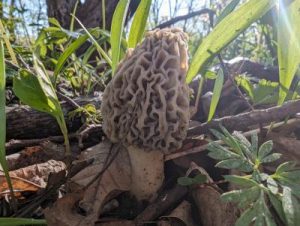Avid Iowa mushroom hunter offers tips on ‘false morels’
May 2nd, 2025 by Ric Hanson
(Radio Iowa) – A contract botanist from northeast Iowa who says he’s eaten more than a hundred species of wild Iowa mushrooms says he wants to set the record straight about what some mushroom hunters call “false” morels. Ben Hoksch, of Elkader, describes himself as a longtime forager of wild plants and mushrooms, who has a master’s degree in biology from U-N-I. “The term false morel is a common name that actually encompasses a large group of mushrooms, of which the most commonly identified mushrooms as false morels,” Hoksch says, “which in Iowa can be seven or eight or nine species, none of them are poisonous.” Though he notes, if you go to other parts of the country, there are mushrooms called false morels, some of which are poisonous. Hoksch has spent years learning the characteristics of various plants to distinguish between things that might be hazardous and those that are nutritious and delicious.
“To the lay person, two mushrooms can look superficially similar,” Hoksch says. “They can say, ‘I can’t tell the difference between those two,’ but an individual that spends any amount of time in the woods studying the features of these can easily tell the difference between something that’s called a false morel — which there aren’t any poisonous ones in Iowa — and a morel.” The key to mushroom hunting, he says, is to learn from others who are well-trained and knowledgeable.”The Prairies States Mushroom Club, they’re based out of Cedar Rapids,” Hoksch says. “They’re a great organization and honestly, a lot of the identification groups on social media do a good job, if you can rifle through the lay people who comment and look to the group experts and moderators of the well-recognized pages.”

Common morel mushroom (Photo by Iowa State University Extension and Outreach)
Hoksch says wild food is everywhere around us and his breakfast most mornings is as local as it gets. “I walked down to the river. I picked three different types of wild greens. I picked cutleaf coneflower, nettles and wild mustard. I cooked that up with eggs from the backyard and a steak of venison that I harvested last winter,” Hoksch says. “Food didn’t always come from a grocery store, and I still think today it’s a great way to connect with the land and have a deeper connection with community.”


